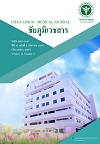Clinical characteristics of cardiac arrest patients at Emergency department Debaratana Nakhon Ratchasima Hospital
Keywords:
return of spontaneous circulation (ROSC), cardiopulmonary resuscitation (CPR), cardiac arrest, out-of-hospital cardiac arrestAbstract
Objective: To determine clinical characteristics of cardiac arrest patients and success rates of adult cardiopulmonary resuscitation at the emergency room Debaratana Nakhon Ratchasima Hospital
Materials and Methods: to review retrospectively the case series of cardiac arrest patients and received CPR at Emergency department at Debaratana Nakhon Ratchasima Hospital between October 2016 and September 2019
Result: From 104 patients, Male more than female, the mean age was 59 years. Out of hospital cardiac arrest patients 87.5%, in hospital cardiac arrest 12.5%, the success rates of CPR were ROSC 41.9%, survival rate of in hospital cardiac arrest more than out of hospital cardiac arrest, bystander CPR 15% that bystander CPR ROSC rate 64.3%, transported to the emergency room by ambulance was 47.1%. Prehospital of adrenaline administered, Duration of CPR of 5 minutes or less and adrenaline administration less than 5 minutes had higher rates of ROSC. The most common causes of cardiac arrest were heart disease but respiratory cause most high ROSC rates.
Conclusion: Early detection important. ROSC related to time of start CPR, transport by ambulance, time of adrenaline administration and bystander CPR
References
Mozaffarian D, Benjamin EJ, Go AS, Arnett DK, Blaha MJ, Cushman M, et al. (2016). Executive Summary:Heart Disease and Stroke Statistics--2016 Update: A Report From the American Heart Association. Circulation, 133(4):447-54.
Chan PS, Berg RA, John A. Spertus, Lee H. Schwamm, Deepak L. Bhatt, Gregg C. Fonarow, et al. (2013). Risk-Standardizing Survival for In-Hospital Cardiac Arrest to Facilitate Hospital Comparisons. J Am Coll Cardiol, 62(7): 601–9.
Veronese JP, Wallis L, Allgaier R, Botha R. (2018). Cardiopulmonary resuscitation by Emergency Medical Services in South Africa: Barriers to achieving high quality performance. Afr J Emerg Med, 8(1):6-11.
กระทรวงสาธารณสุข. (2559). รายงานประจำปี 2559. นนทบุรี : สำนักโรคไม่ติดต่อ กรมควบคุมโรค กระทรวงสาธารณสุข.
Meaney PA, Bobrow BJ, Mancini ME, Christenson J, de Caen AR, Bhanji F, et al. (2013). Cardiopulmonary resuscitation quality: [corrected] improving cardiac resuscitation outcomes both inside and outside the hospital: a consensus statement from the American Heart Association. Circulation, 128(4):417-35.
Kunkongkaphan M, Janphan T. (2015). Characteristics of cardiac arrest patients and factors associated with return of spontaneous circulationsuccess at the emergency department Maesai Hospital Chiang Rai province. Nursing Public Health and Education Journal, 16(1):53-66.
วสันต์ ลิ่มสุริยกานต์. (2561). ปัจจัยที่มีผลต่อความสำเร็จในการฟื้นคืนชีพของผู้ป่วยหัวใจหยุดเต้นนอกโรงพยาบาล ที่ได้รับการช่วยฟื้นคืนชีพในห้องฉุกเฉินโรงพยาบาลพระนครศรีอยุธยา. วารสารสมาคมเวชศาสตร์ป้องกันแห่งประเทศไทย, 8(1):15-23.
Tantarattanapong S, Wuthisuthimethawee P. (2020). Success Rate and Predictors of Adult Cardiopulmonary Resuscitation at the Emergency Room in a University Hospital. J Med Assoc Thai, 103(5):481-7.
Krittayaphong R, Saengsung P, Chawaruechai T. Factors Predicting Outcome of Cardiopulmonary Resuscitation in a Developing Country: The Siriraj Cardiopulmonary Resuscitation Registry. J Med Assoc Thai, 92(5):618-23.
ประไพ บรรณทอง, พัชรี พงษ์พานิช, ณัฐภร ประกอบ. (2560). การดูแลผู้ป่วยภาวะหัวใจหยุดเต้นที่เข้ารับบริการในหน่วยงานผู้ป่วยอุบัติเหตุและฉุกเฉินโรงพยาบาลชัยนาทนเรนทร. ชัยนาท : โรงพยาบาลชัยนาทนเรนทร.
สุรภา ขุนทองแก้ว. (2562). การศึกษาปัจจัยที่มีความสัมพันธ์ต่อการใช้บริการการแพทย์ฉุกเฉิน จังหวัดราชบุรี. วารสารวิทยาลัยพยาบาลพระจอมเกล้า จังหวัดเพชรบุรี, 2(1):30-44.
Downloads
Published
Versions
- 2021-08-17 (3)
- 2021-08-02 (2)
- 2021-02-09 (1)
Issue
Section
License
Copyright (c) 2021 Chaiyaphum Medical Journal : ชัยภูมิเวชสาร

This work is licensed under a Creative Commons Attribution-NonCommercial-NoDerivatives 4.0 International License.





